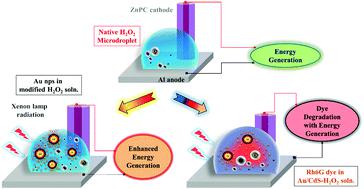当前位置:
X-MOL 学术
›
Nanoscale Adv.
›
论文详情
Our official English website, www.x-mol.net, welcomes your
feedback! (Note: you will need to create a separate account there.)
Microdroplet photofuel cells to harvest high-density energy and dye degradation
Nanoscale Advances ( IF 4.6 ) Pub Date : 2020-02-28 , DOI: 10.1039/c9na00785g Siddharth Thakur 1 , Nayan Mani Das 2 , Sunny Kumar 1 , Ashok Kumar Dasmahapatra 1, 2 , Dipankar Bandyopadhyay 1, 2
Nanoscale Advances ( IF 4.6 ) Pub Date : 2020-02-28 , DOI: 10.1039/c9na00785g Siddharth Thakur 1 , Nayan Mani Das 2 , Sunny Kumar 1 , Ashok Kumar Dasmahapatra 1, 2 , Dipankar Bandyopadhyay 1, 2
Affiliation

|
In this study, a membraneless photofuel cell, namely, μ-DropFC, was designed and developed to harvest chemical and solar energies simultaneously. The prototypes can also perform environmental remediation to demonstrate their multitasking potential as a sustainable hybrid device in a single embodiment. A hydrogen peroxide (H2O2) microdroplet at optimal pH and salt loading was utilized as a fuel integrated with Al as an anode and zinc phthalocyanine (ZnPC)-coated Cu as a cathode. The presence of n-type semiconductor ZnPC in between the electrolyte and metal enabled the formation of a photo-active Schottky junction suitable for power generation under light. Concurrently, the oxidation and reduction of H2O2 on the electrodes helped in the conversion of chemical energy into the electrical one in the same membraneless setup. The suspension of Au nanoparticles (Au NPs) in the droplet helped in enhancing the overall power density under photonic illumination through the effects of localized surface plasmon resonance (LSPR). Furthermore, the presence of photo-active n-type CdS NPs enabled the catalytic photo-degradation of dyes under light in the same embodiment. A 40 μL μ-DropFC could show a significantly high open circuit potential of ∼0.58 V along with a power density of 0.72 mW cm−2. Under the same condition, the integration of ten such μ-DropFCs could produce a power density of ∼7 mW cm−2 at an efficiency of 3.4%, showing the potential of the prototype for a very large scale integration (VLSI). The μ-DropFC could also degrade ∼85% of an industrial pollutant, rhodamine 6G, in 1 h while generating a power density of ∼0.6 mW cm−2. The performance parameters of μ-DropFCs were found to be either comparable or superior to the existing prototypes. In a way, the affordable, portable, membraneless, and high-performance μ-DropFC could harvest energy from multiple resources while engaging in environmental remediation.
中文翻译:

微滴光燃料电池收集高密度能量和染料降解
在这项研究中,设计和开发了一种无膜光燃料电池,即μ-DropFC,用于同时收集化学能和太阳能。原型还可以进行环境修复,以在单个实施例中展示其作为可持续混合设备的多任务潜力。采用最佳pH和盐负载下的过氧化氢(H 2 O 2 )微滴作为燃料,与Al作为阳极和锌酞菁(ZnPC)涂层的Cu作为阴极集成。电解质和金属之间存在 n 型半导体 ZnPC,能够形成适合在光下发电的光敏肖特基结。同时,在相同的无膜装置中,电极上 H 2 O 2的氧化和还原有助于将化学能转化为电能。液滴中悬浮的金纳米颗粒(Au NP)有助于通过局域表面等离子体共振(LSPR)的作用提高光子照明下的整体功率密度。此外,在同一实施例中,光活性n型CdS NP的存在使得染料能够在光下催化光降解。 40 μL μ-DropFC 可以表现出~0.58 V 的极高开路电位以及 0.72 mW cm -2的功率密度。在相同条件下,集成10个这样的μ-DropFC可以产生~7 mW cm -2的功率密度,效率为3.4%,显示了原型用于超大规模集成(VLSI)的潜力。 μ-DropFC 还可以在 1 小时内降解约 85% 的工业污染物罗丹明 6G,同时产生约 0.6 mW cm -2的功率密度。 μ-DropFC 的性能参数与现有原型相当或优于现有原型。在某种程度上,经济实惠、便携式、无膜和高性能的μ-DropFC可以从多种资源中获取能量,同时参与环境修复。
更新日期:2020-02-28
中文翻译:

微滴光燃料电池收集高密度能量和染料降解
在这项研究中,设计和开发了一种无膜光燃料电池,即μ-DropFC,用于同时收集化学能和太阳能。原型还可以进行环境修复,以在单个实施例中展示其作为可持续混合设备的多任务潜力。采用最佳pH和盐负载下的过氧化氢(H 2 O 2 )微滴作为燃料,与Al作为阳极和锌酞菁(ZnPC)涂层的Cu作为阴极集成。电解质和金属之间存在 n 型半导体 ZnPC,能够形成适合在光下发电的光敏肖特基结。同时,在相同的无膜装置中,电极上 H 2 O 2的氧化和还原有助于将化学能转化为电能。液滴中悬浮的金纳米颗粒(Au NP)有助于通过局域表面等离子体共振(LSPR)的作用提高光子照明下的整体功率密度。此外,在同一实施例中,光活性n型CdS NP的存在使得染料能够在光下催化光降解。 40 μL μ-DropFC 可以表现出~0.58 V 的极高开路电位以及 0.72 mW cm -2的功率密度。在相同条件下,集成10个这样的μ-DropFC可以产生~7 mW cm -2的功率密度,效率为3.4%,显示了原型用于超大规模集成(VLSI)的潜力。 μ-DropFC 还可以在 1 小时内降解约 85% 的工业污染物罗丹明 6G,同时产生约 0.6 mW cm -2的功率密度。 μ-DropFC 的性能参数与现有原型相当或优于现有原型。在某种程度上,经济实惠、便携式、无膜和高性能的μ-DropFC可以从多种资源中获取能量,同时参与环境修复。











































 京公网安备 11010802027423号
京公网安备 11010802027423号